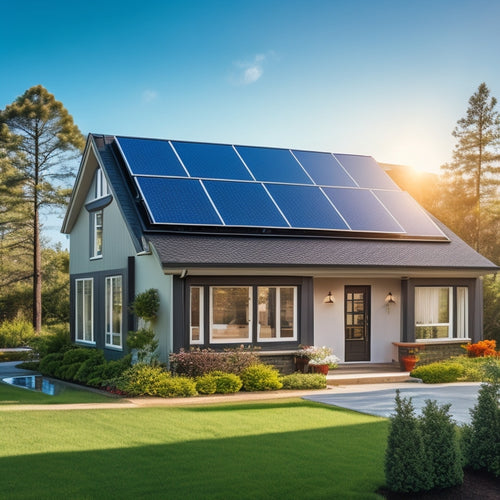
Buying a Solar Array for Home Considerations
Share
When buying a solar array for your home, consider your energy needs by analyzing your consumption patterns and identifying peak usage hours and energy-intensive appliances. Choosing the right equipment involves selecting efficient panels and inverters, evaluating their durability and warranty, and confirming compatibility with your local electrical grid. Initial installation costs, maintenance expenses, and incentives like federal tax credits and local rebates also factor into your decision. Additionally, understand local regulations, such as zoning laws and permit requirements, to guarantee a smooth installation. As you weigh these factors, you'll uncover more details that will help you make an informed decision for your solar-powered future.
Key Takeaways
- Analyze your energy consumption patterns to accurately size your solar array and ensure it meets your energy needs throughout the year.
- Choose the right equipment, including efficient and durable panels, inverters, and mounting systems, that fit your budget and local building codes.
- Calculate the total cost of ownership, including installation, maintenance, and potential repairs, to determine the financial viability of your solar array.
- Research and factor in available incentives, such as federal and state tax credits, rebates, and grants, to reduce the upfront cost of your solar array.
- Ensure compliance with local regulations, including zoning laws, permits, and homeowner association rules, to avoid installation delays and potential penalties.
Assessing Your Energy Needs
Determining how much energy your home consumes is essential in sizing a solar array that meets your needs. To do this, you need to analyze your energy consumption patterns over a year.
Review your past utility bills to identify your peak usage hours, typically during summer afternoons when air conditioning is in high demand. This information will help you determine the required system size and configuration.
You should also consider your energy usage during periods of low sunlight, such as winter months. Understanding your energy needs during these periods will guarantee your solar array can provide sufficient power.
Take note of any energy-intensive appliances, like electric water heaters or pool pumps, that may require additional power.
Choosing the Right Equipment
Now that you've calculated your energy needs, it's time to select the right equipment for your solar array. The type of solar panels you choose will greatly impact your system's performance and cost.
You'll need to decide between monocrystalline, polycrystalline, and thin-film panel types, each with its own advantages and disadvantages. Monocrystalline panels are the most efficient but also the most expensive, while thin-film panels are less efficient but more affordable.
When it comes to inverter options, you'll need to choose between string inverters, microinverters, and power optimizers. String inverters are the most common and cost-effective option, but microinverters and power optimizers offer more flexibility and monitoring capabilities.
Consider factors like efficiency, durability, and warranty when making your decision. Additionally, confirm the equipment you choose is compatible with your local electrical grid and meets local building codes.
It's crucial to weigh the pros and cons of each option to find the best fit for your energy needs and budget.
Installation and Maintenance Costs
As you bring your solar array to life, the upfront cost of installation is just the beginning. You'll need to reflect on the ongoing expenses associated with maintaining your system to guarantee it operates efficiently.
| Task | Timeline | Cost |
|---|---|---|
| Initial Installation | 1-3 days | $2,000 - $5,000 |
| Bi-Annual Inspection | Every 6 months | $100 - $300 |
| Panel Cleaning | Quarterly | $50 - $200 |
| Inverter Replacement | Every 10-15 years | $1,000 - $3,000 |
| System Monitoring | Ongoing | $100 - $500 per year |
You'll want to factor in installation timelines, which can range from a few days to several weeks, depending on the complexity of the project. Additionally, maintenance schedules will vary, but you can expect to pay for bi-annual inspections, quarterly panel cleaning, and inverter replacements every 10-15 years. System monitoring costs will also add up over time. While these expenses may seem intimidating, they're essential to guaranteeing your solar array operates at peak performance and maximizing your return on investment.
Evaluating Incentives and Rebates
While ensuring your solar array operates efficiently is crucial, you can offset some of the maintenance costs by taking advantage of available incentives and rebates.
As a homeowner, you're eligible for federal tax credits, which can greatly reduce your tax liability. Currently, the Solar Investment Tax Credit (ITC) allows you to claim 26% of the total cost of your solar array as a credit on your federal taxes.
Additionally, many states offer their own incentives, such as rebates, grants, or property tax exemptions. These state incentives can vary widely, so it's important to research what's available in your area.
You may also be eligible for local incentives, such as rebates from your utility company or municipality. Be sure to factor these incentives into your overall cost calculation to get a more accurate representation of your solar array's financial benefits.
Considering Local Regulations
One essential aspect of buying a solar array for your home is guaranteeing compliance with local regulations, which can vary considerably from one jurisdiction to another. You'll need to research and understand the specific laws and requirements in your area before installing a solar array.
| Regulation | Description |
|---|---|
| Zoning Laws | Determine the allowed size and placement of your solar array on your property. |
| Permit Requirements | Outline the necessary permits and inspections required before and during installation. |
| Homeowner Associations | May have rules governing the appearance and installation of solar arrays in your neighborhood. |
| Environmental Impact | Assess the potential environmental effects of your solar array, such as shading or habitat disruption. |
Failing to comply with local regulations can result in fines, removal of the solar array, or even legal action. You should consult with local authorities, your solar panel provider, and homeowner association (if applicable) to guarantee a smooth installation process. By understanding and complying with local regulations, you can avoid potential issues and enjoy the benefits of your solar array.
Frequently Asked Questions
Can I Install Solar Panels on My Roof if It's Shaded?
"Absence of evidence doesn't mean evidence of absence." You can still install solar panels on a roof with shaded areas, but be aware that it'll reduce solar efficiency; assess the shade's impact and consider strategies to mitigate its effects.
Will Solar Panels Increase My Home's Insurance Premium?
You're wondering if solar panels will hike your home's insurance premium; typically, they won't, but it depends on your insurance policy. The solar panel impact is usually minimal, as the added value is often offset by the increased property value, leaving your premium relatively unchanged.
Can I Sell Excess Energy Back to the Grid?
You can sell excess energy back to the grid through net metering, benefiting from energy buyback rates that vary by utility and state, allowing you to offset your energy costs and even earn credits towards future bills.
Do Solar Panels Require Regular Cleaning?
You'll want to clean your solar panels regularly to maintain peak solar efficiency, as dirt and debris can reduce energy output by up to 25%. Regular cleaning helps minimize maintenance costs, ensuring you maximize your investment's power potential.
Can I Finance My Solar Array Purchase With a Home Equity Loan?
You're maneuvering a financial maze, searching for the right financing route; fortunately, a home equity loan can be a guiding light, offering competitive interest rates and loan benefits, making it a viable option for financing your solar array purchase.
Related Posts
-

Step-by-Step Guide to Converting Your Vehicle to EV
You'll begin by evaluating your vehicle's conversion potential, analyzing its weight, aerodynamics, and powertrain co...
-

What Are the Average Cost Savings of Solar Panels
You can expect to save between $400 and $1,000 per year on your electricity bills with solar panels, which translates...
-

Solar Power Units Perfect for Homes
You're considering installing a solar power unit in your home, a decision that can notably reduce your reliance on tr...


